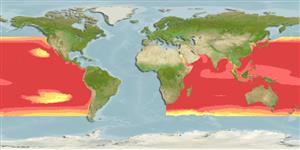Preferred temperature (Ref.
115969): 14.6 - 28.3, mean 25.9 (based on 1534 cells).
Phylogenetic diversity index (Ref.
82804): PD
50 = 0.7505 [Uniqueness, from 0.5 = low to 2.0 = high].
Bayesian length-weight: a=0.00550 (0.00297 - 0.01015), b=3.15 (2.98 - 3.32), in cm Total Length, based on LWR estimates for this species & (Sub)family-body (Ref.
93245).
Trofisk nivå (Ref.
69278): 4.5 ±0.73 se; based on food items.
Resiliens (Ref.
120179): Mellan, lägsta populationsfördubblingstid 1,4-4,4 år (K=0.2-0.6; tm=2-3; Fec=90-281 million (annual reproductive output)).
Prior r = 0.37, 95% CL = 0.25 - 0.56, Based on 6 full stock assessments.
Fishing Vulnerability (Ref.
59153): Moderate vulnerability (44 of 100).
Climate Vulnerability (Ref.
125649): Moderate to high vulnerability (48 of 100).
